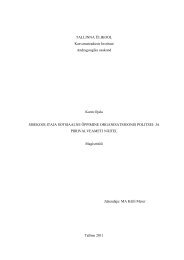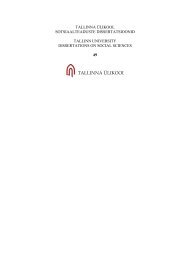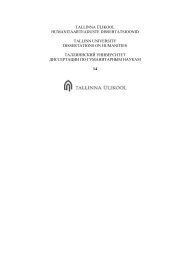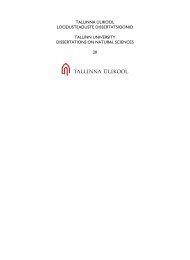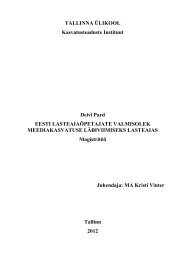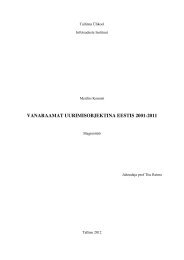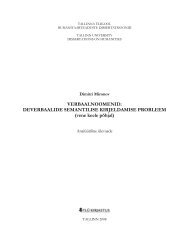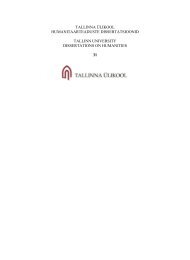Create successful ePaper yourself
Turn your PDF publications into a flip-book with our unique Google optimized e-Paper software.
there were men and women living very long, i.e. 75 years or more. Alongside with legalmarriages there were cohabitation partnerships that were not formalized in the first half of the16 th century Uus-Pärnu. In the town there lived the partners and children of many a memberof the Order or of Catholic clerics. These partnerships and the children born of them weresocially acceptable and highly tolerated in Uus-Pärnu as in Livonia at large. One of thereasons for that could have been the high social status of the Order and the clergymen. Themass violation of the celibacy vow was favoured and justified by the Reformation. Womenwere responsible for the domestic household providing care for the family but they also hadtheir role in the economy of Uus-Pärnu. Women were cherished as auxiliary labour force inbig households where they could earn their living as housekeepers, maids, wet nurses orchildminders. There are records of widowed ladies who continued with the business of theirhusbands or took up their own.In the early 16 th century there were six churches in Uus-Pärnu and at least three religiousbrotherhoods. It is conspicuous, however, that there was no cloister. There are data from theearly 16 th century about attempts to found a Franciscan and/or a Dominican monastery but thesewere turned down by the citizens. A medieval attraction of Uus-Pärnu was not only its marketand the port but also the holy relic, the Black Cross. It was preserved in St. Nicholas Church,the destination of local pilgrims. Saints were revered in Uus-Pärnu like in other Livonian townswith no local differences (excluding the presence of the local relic). There were, however, a fewgeneral tendencies in the observance of cults like the veneration of St. Anna gaining momentumduring the late Middle Ages throughout Europe. The religious life of Uus-Pärnu was dominatedby the German Order as the cults of the saints favoured by the Order (the Virgin Mary, StBarbara) were highly subsidized in Uus-Pärnu. In addition, the Order gave considerablecontribution to the relic of the Black Cross. It is also noteworthy that the non-Germans of Uus-Pärnu had their preacher already prior to the Reformation.There are no doubts that the pivotal axis for the history of Uus-Pärnu in the first half of the16 th century was the Reformation converging not only important ecclesiastical and religiousprocesses but also major social, political and cultural developments in the city. These are thewritten records of Uus-Pärnu, occasioned by the Reformation, that testify to the significance ofthe latter: burgomaster Johann van Lynthem put down his memoirs, the register of St. Nicholaschurch became the town register writing up the rent charges for plots taken over from thechurch. One of the most intriguing aspects of the Livonian Reformation is the speed on which itreached and spread in Livonia. The phenomenon is not easy to explain and it would be naïve tosuppose that a closer look at the events in Uus-Pärnu can reveal the one and the only truth. Butit can give additional possibilities for interpretation. Probably there was no single cause for thequick and triumphal progress of the Reformation dependent as it is on versatile factors. First, ofsignificance is what had happened in Livonia prior the Reformation, i.e. the mental atmospherethat surrounded and shaped the minds of the potential performers/receivers of the Reformationideas. Here one cannot bypass the influence of the Renaissance and the humanist ideas. TheReformation was an aspect of the more general mental “awakening” initiated by theRenaissance. The impact of the latter concerned in Livonia not only the high culture and thearts. There are only a few style samples of the Renaissance art in Uus-Pärnu: one stonewindow jamb, a few gravestones and the gable of a court-hall, all of them perished by today.At the same time, the fortifications of Uus-Pärnu followed the principles prevalent in the early16 th century Renaissance defence constructions. The Renaissance ideology can be intuited in thedaily life of the citizens. The levels of housekeeping and living conditions in Uus-Pärnu were inharmony with the general progress of consumption habits depending in their turn on theincreased role of comfort and personality in the Europe of the late Middle and the Early ModernAge. The reform attempts of the medieval church and the critique of the Holy Seat were232




